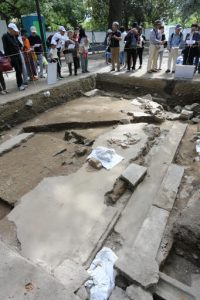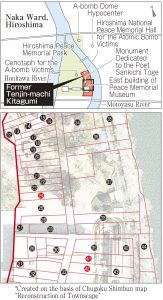Striving to fill voids in Hiroshima 75 years after the atomic bombing—Chugoku Shimbun finds evidence of lives lost, confirms deaths of six people in three families in former Tenjin-machi area
Jan. 1, 2020
by Kyosuke Mizukawa, Staff Writer
As of December 31, the Chugoku Shimbun newly confirmed information on the A-bomb deaths of six people from three families who lived in the former Tenjin-machi Kitagumi area, now part of Hiroshima Peace Memorial Park in Naka Ward. Details about where the individuals lived in the area devastated in the atomic bombing were also confirmed. The information resulted from interviews of surviving family members. A-bombed remains from part of the Tenjin-machi Kitagumi area are scheduled to be made available to the public by the Hiroshima City government during fiscal 2020. Hiroshima City will use the information on the victims in the area as reference for drawing up its plans for the exhibit site.
The three families were headed by Iwaso Sakai, who was then 60, Sangoro Okusa, 67, and Hisao Gotanda, 54. All the families’ members perished in the atomic bombing, except for one person, who survived and later moved away from the city of Hiroshima.
With support from surviving family members and former residents of Tenjin-machi Kitagumi, the Chugoku Shimbun ran a series of feature articles from 1997 to 2000 titled “Photographs of the Dead Speak.” The articles looked into the existence of each of the individuals present at the hypocenter area at the time of the atomic bombing and were able to identify 163 people who died in the atomic bombing by the end of 1945. In a summary of the series, the newspaper developed the map “Reconstruction of Townscape near the Peace Memorial Park (Hypocenter),” which is being used by the City as reference when conducting excavation surveys of the park. Some home sites are left vacant on the map, however, because relevant information could not be confirmed.
The present-day Peace Memorial Park area is close to the hypocenter and was devastated in the atomic bombing on August 6, 1945. After the end of the war, soil was used to cover the ruins, on top of which the park was developed. In the lead up to the milestone 75th anniversary of the atomic bombing, plans are moving ahead for the exhibit of the remains of A-bombed houses and streets that were part of the former Tenjin-machi Kitagumi area. Against this backdrop, the Chugoku Shimbun once again worked to identify family members of the area’s unidentified victims. With a recently published collection of A-bomb survivors’ testimonies and other sources as clues, the whereabouts of the surviving family members of the three families were discovered.
Some of the former residents of Tenjin-machi Kitagumi who survived the atomic bombing participated in the “Hypocenter Reconstruction Survey,” carried out by Hiroshima University and others from the late 1960s through the 1970s. The reconstruction survey gathered information on the conditions of A-bomb damage in the area and the whereabouts of victims’ surviving families. However, the survey apparently failed to obtain detailed information on the three families, because they suffered utter annihilation or some other fate in the atomic bombing.
Surviving relatives of two of the families have kept photographs of the victims and their homes at that time. The Hiroshima City Peace Promotion Division is now preparing for the exhibit of A-bombed remains uncovered in and around what was the Nakajima district, part of Peace Memorial Park at present, to convey to visitors information about the residents’ lives and the destruction resulting from the atomic bombing. “Testimonies and photographs about the area before the atomic bombing are valuable,” said a city official in the division. “We want to use them as reference when developing our exhibit plan.”
Keywords
Photographs of the Dead Speak
With cooperation from surviving family members, the Chugoku Shimbun worked to trace the A-bomb deaths of those in the former six towns of the hypocenter area (what is now Peace Memorial Park in Naka Ward), including residents, workers, and school children mobilized to dismantle buildings for the creation of fire lanes. From 1997 to 2000, the circumstances of 2,369 people were confirmed, with 85 percent of that total identified as having died on August 6, 1945. Of the photographs taken of 1,882 deceased and donated by surviving families, 1,655 have been archived and made available to the public at the Hiroshima National Peace Memorial Hall for the Atomic Bomb Victims since its opening in 2002, based on agreement from the families.
(Originally published on January 1, 2020)
1. Naka Ward, Hiroshima
2. Cenotaph for the A-bomb Victims
3. Honkawa River
4. Former Tenjin-machi Kitagumi
5. Hiroshima Peace Memorial Park
6. A-bomb Dome
7. Hypocenter
8. Hiroshima National Peace Memorial Hall for the Atomic Bomb Victims
9. Monument Dedicated to the Poet Sankichi Toge
10. East building of Peace Memorial Museum
11. Motoyasu River
12. Tomota (lacquerware shop)
13. Tomota
14. Warehouse
15. Teranishi
16. Matsuda (bicycle shop), Yamaji
17. Kato (lumber shop)
18. Kano, Takeda
19. Printing office
20. Niiuchi (construction materials shop)
21. Dogouchi
22. Kawano
23. Tamura
24. Mr. Sakai’s home (antique shop)
25. Sano (charcoal shop)
26. Masuda (accountant’s office)
27. Kunimoto
28. Fujii Brothers Co. (Nishihiro)
29. Ishii Pawnshop
30. Hara (carpenter)
31. Kotaki
32. Yamasaki, Yonegawa
33. Tenjin-machi-suji
34. Prefecture Dental Association Office
35. Niitani
36. Shindo Pediatrics
37. Amagi Inn (Amagi), residence of Umemura
38. Amagi Taxi (Ono)
39. Fujii Co.’s warehouse
40. Takahei (Suehiro noodle shop)
41. Mr. Okusa’s home
42. Mr. Gotanda’s home
43. Kikuchi (fabric shop)
44. Hirata (earthworks business)
45. *Created on the basis of Chugoku Shimbun map “Reconstruction of Townscape”
Hiroshima City: “Information will be used for exhibit of the area’s remains”
As of December 31, the Chugoku Shimbun newly confirmed information on the A-bomb deaths of six people from three families who lived in the former Tenjin-machi Kitagumi area, now part of Hiroshima Peace Memorial Park in Naka Ward. Details about where the individuals lived in the area devastated in the atomic bombing were also confirmed. The information resulted from interviews of surviving family members. A-bombed remains from part of the Tenjin-machi Kitagumi area are scheduled to be made available to the public by the Hiroshima City government during fiscal 2020. Hiroshima City will use the information on the victims in the area as reference for drawing up its plans for the exhibit site.
The three families were headed by Iwaso Sakai, who was then 60, Sangoro Okusa, 67, and Hisao Gotanda, 54. All the families’ members perished in the atomic bombing, except for one person, who survived and later moved away from the city of Hiroshima.
With support from surviving family members and former residents of Tenjin-machi Kitagumi, the Chugoku Shimbun ran a series of feature articles from 1997 to 2000 titled “Photographs of the Dead Speak.” The articles looked into the existence of each of the individuals present at the hypocenter area at the time of the atomic bombing and were able to identify 163 people who died in the atomic bombing by the end of 1945. In a summary of the series, the newspaper developed the map “Reconstruction of Townscape near the Peace Memorial Park (Hypocenter),” which is being used by the City as reference when conducting excavation surveys of the park. Some home sites are left vacant on the map, however, because relevant information could not be confirmed.
The present-day Peace Memorial Park area is close to the hypocenter and was devastated in the atomic bombing on August 6, 1945. After the end of the war, soil was used to cover the ruins, on top of which the park was developed. In the lead up to the milestone 75th anniversary of the atomic bombing, plans are moving ahead for the exhibit of the remains of A-bombed houses and streets that were part of the former Tenjin-machi Kitagumi area. Against this backdrop, the Chugoku Shimbun once again worked to identify family members of the area’s unidentified victims. With a recently published collection of A-bomb survivors’ testimonies and other sources as clues, the whereabouts of the surviving family members of the three families were discovered.
Some of the former residents of Tenjin-machi Kitagumi who survived the atomic bombing participated in the “Hypocenter Reconstruction Survey,” carried out by Hiroshima University and others from the late 1960s through the 1970s. The reconstruction survey gathered information on the conditions of A-bomb damage in the area and the whereabouts of victims’ surviving families. However, the survey apparently failed to obtain detailed information on the three families, because they suffered utter annihilation or some other fate in the atomic bombing.
Surviving relatives of two of the families have kept photographs of the victims and their homes at that time. The Hiroshima City Peace Promotion Division is now preparing for the exhibit of A-bombed remains uncovered in and around what was the Nakajima district, part of Peace Memorial Park at present, to convey to visitors information about the residents’ lives and the destruction resulting from the atomic bombing. “Testimonies and photographs about the area before the atomic bombing are valuable,” said a city official in the division. “We want to use them as reference when developing our exhibit plan.”
Keywords
Photographs of the Dead Speak
With cooperation from surviving family members, the Chugoku Shimbun worked to trace the A-bomb deaths of those in the former six towns of the hypocenter area (what is now Peace Memorial Park in Naka Ward), including residents, workers, and school children mobilized to dismantle buildings for the creation of fire lanes. From 1997 to 2000, the circumstances of 2,369 people were confirmed, with 85 percent of that total identified as having died on August 6, 1945. Of the photographs taken of 1,882 deceased and donated by surviving families, 1,655 have been archived and made available to the public at the Hiroshima National Peace Memorial Hall for the Atomic Bomb Victims since its opening in 2002, based on agreement from the families.
(Originally published on January 1, 2020)
1. Naka Ward, Hiroshima
2. Cenotaph for the A-bomb Victims
3. Honkawa River
4. Former Tenjin-machi Kitagumi
5. Hiroshima Peace Memorial Park
6. A-bomb Dome
7. Hypocenter
8. Hiroshima National Peace Memorial Hall for the Atomic Bomb Victims
9. Monument Dedicated to the Poet Sankichi Toge
10. East building of Peace Memorial Museum
11. Motoyasu River
12. Tomota (lacquerware shop)
13. Tomota
14. Warehouse
15. Teranishi
16. Matsuda (bicycle shop), Yamaji
17. Kato (lumber shop)
18. Kano, Takeda
19. Printing office
20. Niiuchi (construction materials shop)
21. Dogouchi
22. Kawano
23. Tamura
24. Mr. Sakai’s home (antique shop)
25. Sano (charcoal shop)
26. Masuda (accountant’s office)
27. Kunimoto
28. Fujii Brothers Co. (Nishihiro)
29. Ishii Pawnshop
30. Hara (carpenter)
31. Kotaki
32. Yamasaki, Yonegawa
33. Tenjin-machi-suji
34. Prefecture Dental Association Office
35. Niitani
36. Shindo Pediatrics
37. Amagi Inn (Amagi), residence of Umemura
38. Amagi Taxi (Ono)
39. Fujii Co.’s warehouse
40. Takahei (Suehiro noodle shop)
41. Mr. Okusa’s home
42. Mr. Gotanda’s home
43. Kikuchi (fabric shop)
44. Hirata (earthworks business)
45. *Created on the basis of Chugoku Shimbun map “Reconstruction of Townscape”









